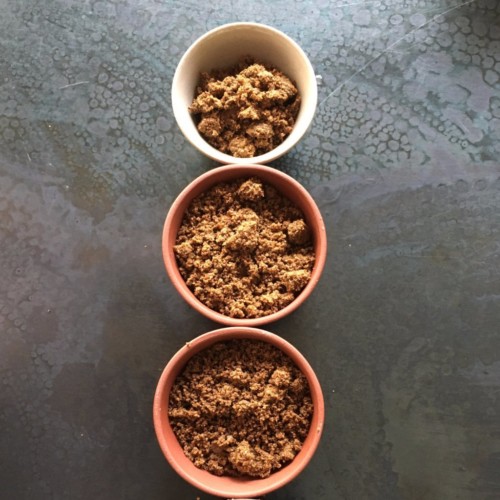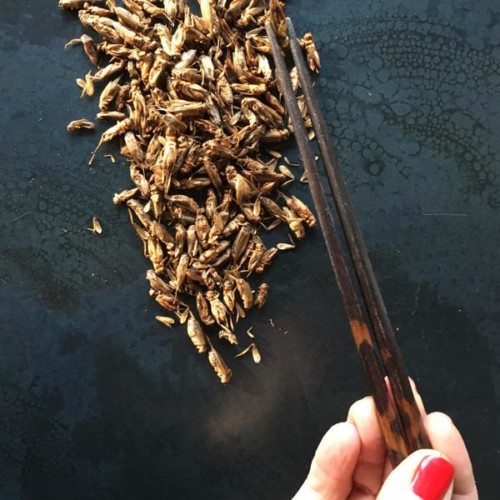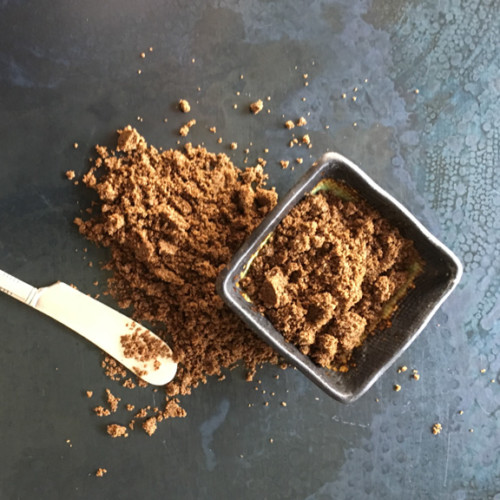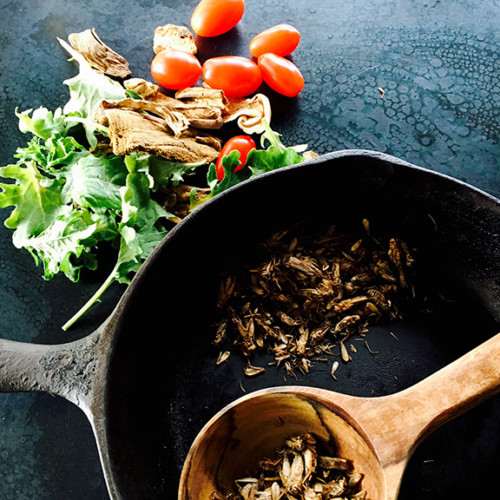How a Cricket Farm in Austin is Putting a Dent in World Hunger
Silence.
“Crickets are quiet when they’re babies,” explains Gabe Mott, one of the partners in Aspire, a food-grade cricket farm in Austin, Texas. Mott leads me from the nursery, where dense mats embedded with cricket eggs smaller than poppy seeds will hatch and become mobile within a week, to the room where a couple of thousand mature crickets already reside. These are the noisy guys and, in about a month, they’ll be on someone’s dinner plate.
Mott and partners, two of whom were named to last year’s Forbes’ 30 Under 30 list for social enterprise, may seem like they’re running a humble little cricket farm, but they’re really trying to make a dent in world hunger. Edible insects– eaten in places like Mexico, Africa and Thailand for millennia– are high in protein and eco-friendlier than any steak or chicken. Mott says everyone knows that now, though.
“Awareness of edible crickets is high. Wide spread acceptance is the hurdle.” True. In recent years edible cricket entrepreneurs have made their way on to shows like Shark Tank, and nearly everyone has heard of the concept of eating insects thanks partially to a report by the Food and Agriculture Organization of the United Nations titled “Edible Insects: Future Prospects for Food and Feed Security.”
The report says that the global population, now at more than 7 billion, may grow to 9 billion by 2050. Already, nearly 1 billion people regularly go hungry. Despite the interest, though, critters are only now popping up on a smattering of menus around the U.S.
Aspire hopes eating crickets here becomes completely normal, though. Why? Because what we eat is what the world wants to eat. Food, like most consumables, is aspirational.
Back to the bugs, though. They like the temperature and humidity, monitored with an app on Mott’s phone, high. “Around 90 degrees is perfect. In the summer, we don’t have to run the heaters,” says Mott. Weather is part of the reason the partners, who won $1 million Hult Prize for budding social entrepreneurs while they were still MBA students at McGill University in 2013, located their U.S. operations in the south.
Humidity is kept between 30 and 50 percent at the farm, which is just a couple of large buildings situated in South Austin farmland. If humidity edges toward 60 percent there’s a risk of mold, a bane to any cricket farmer. A bug zapper shwaps in the background. “The problem with creating an environment ideal for insects,” says Mott. “Is that it’s ideal for insects.”
Edible insects– eaten in places like Mexico, Africa and Thailand for millennia– are high in protein and eco-friendlier than any steak or chicken. Mott says everyone knows that now, though.
Aspire crickets eat modified chicken feed and get plenty of fresh tap water (the nearby chlorine content isn’t too high). They reside in high-sided boxes with custom-made partitions like condo units. The enclosures are designed for hiding and crawling, which is what any cricket really wants to do. “The adults can, in theory, fly,” says Mott. “But if they fly out of the bin, they don’t breed. Over the decades crickets have self-selected to be non-fliers.”
Once the bugs mature, farm workers – most of whom Mott hires over Craig’s List and these days only occasionally gets a respondent who threatens to report him (A cricket farm? I don’t believe you!) – remove them and place them in bags for freezing. Crickets are ectothermic– cold blooded – Mott explains. With a drop in temperature their response is to go dormant and wait for the place to warm up. “It never warms up for our crickets,” he says.
Mott has eaten vegetarian for nearly 20 years, yet now consumes insects. “My definition of vegetarian is ‘people who don’t eat animals’. A cricket is an animal, I can’t deny that. But if you think about the reasons why people become vegetarian, the ethical and moral justifications, almost every justification is perfectly compatible with eating insects.”
He favors the cricket curry an Austin food truck makes. And anything that Aspire’s Cordon Bleu-trained test chef whips up with Aketta, the high-protein powder the company mills from their crickets. Most recently he’s enamored with granola-crusted cricket cheesecake and raspberry cricket sorbet. “I’m kind of foodie-ish,” he says. “I like good food a lot.”
From the freezer, Aspire crickets are washed and either roasted whole, with or without seasoning, or milled into Aketta. Milled crickets are sometimes called “cricket flour,” but the product isn’t technically flour. Mott says it can replace roughly 1/4 to 1/3 cup of flour in most recipes and turn baked goods more nutrient-dense.
Milled crickets increase protein, iron, calcium, vitamins B and D and they have a subtle umami flavor. “So if you use Aketta in a pancake recipe, you’ll taste a more buckwheat or whole wheat flavor.” People who eat paleo are aligned with eating insects, says Mott. Also people who eat lactose free, gluten free or have a variety of dietary sensitivities.
Mott says anyone with a few crickets, some egg crates and Rubbermaid tubs could even try home cricket farming. Come harvest time, though, make sure the crickets are properly frozen. “At least 24 hours. You don’t want them waking up,” he says. Back in the old days – four years ago- the Aspire team roasted the crickets in their own kitchens. Mott warns that anyone who tries roasting at home should watch the oven carefully; nothing burnt smells good, especially not crickets.
At least half dozen other companies in the U.S. have ventured into industrial cricket farming and many are even manufacturing foods such as nutrition bars with crickets, but Mott says Aspire is sticking with roasted crickets and cricket powder. “For now, we’re comfortable letting others get into the food manufacturing business. We have a lot on our plates.” He brushes a stray cricket from the side of a box. “It’s never boring here.”






































